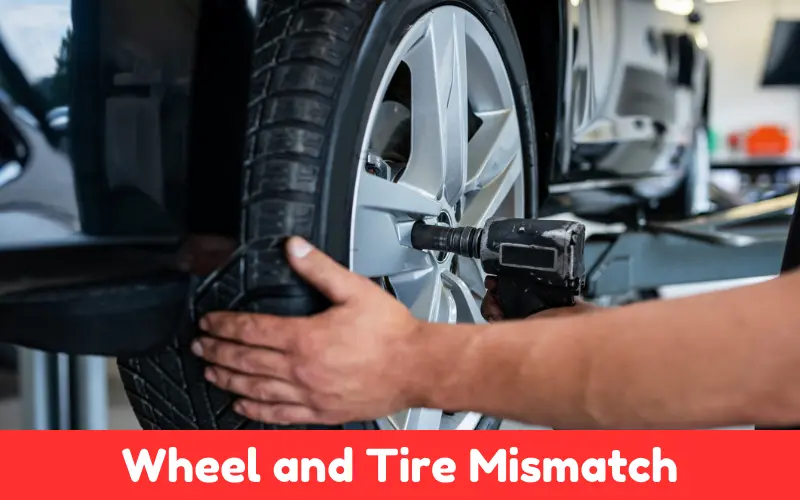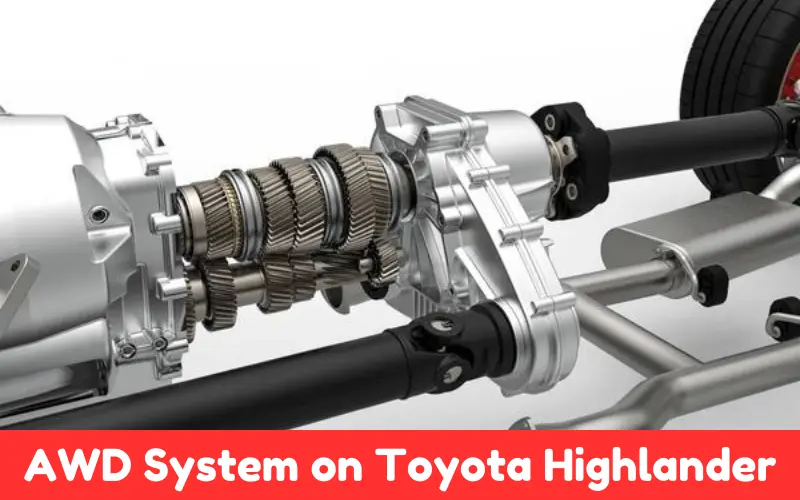The Toyota Highlander has good visibility and a great track record for dependability on the road. Still, if you need a bit more traction and the assurance of being steered safely in any situation, the Toyota Highlander offers an All-Wheel Drive (also known as AWD) system.
Toyota Highlander’s AWD system will give you the confidence to go for it. In this blog, you’ll learn what check AWD system Toyota Highlander means and how and why it works the way it does.
Article Summary
What Does Check AWD System Toyota Highlander Mean?
The warning code Check AWD System alert in a Toyota Highlander indicates a possible problem with the All-Wheel Drive (AWD) system. The system could malfunction, and the issue may cause Traction and handling problems or zero torque to the axle.
The most common causes are a malfunction in a sensor, a failure in the Toyota AWD control unit, or problems in the differential or transfer case.
If you see this indication on the dashboard, you should take action. An essential rule is not to drive the vehicle until the cause of the message is eliminated.
It might be the case that you won’t see any immediate sign, but the fault can damage other components of the AWD system itself, reducing its performance.
If you see this message on your dash, the best thing is to get your hands on your Toyota Highlander’s manual (unless you already know it by heart) and try to perform some basic diagnostics.
Then, you should take the vehicle to a qualified Toyota service center for a specific diagnostic check. A professional Toyota technician will be able to find out which specific cause is causing the Check AWD System alert and perform the necessary phase of repair to restore the correct function to your Toyota Highlander system.
How Does AWD System Work on A Car?
The Toyota Highlander’s automatic AWD has been engineered to deliver traction where it’s most needed. The Highlander’s automatic AWD operates independently and doesn’t require driver involvement.
In essence, it continually monitors the road conditions and automatically delivers the right amount of power to all four wheels as needed. Take a closer look at how this system works.
Regular Driving Conditions
In normal driving conditions, under most circumstances, our AWD system delivers power to the front wheels. This is to maintain the best fuel efficiency on dry, level roads.
Dynamic Traction Control
If wheel slippage is detected, torque is instantly distributed to the rear wheels for enhanced grip. This is especially useful in slippery, wet, or low friction surface conditions such as snow or mud.
Dynamic Torque Control
AWD distributes power between front and rear wheels as needed to enhance traction when driving in varying road conditions.

The dynamic torque control system monitors the vehicle’s speed, steering angle, and throttle input and adjusts the torque applied to the front and rear wheels to enhance traction and minimize understeer and oversteer while cornering and accelerating.
What Causes Check AWD System Light To Come On?
When the Toyota Highlander’s AWD light turns on, it’s not necessarily an immediate cause for concern, but it could indicate a problem with the All-Wheel Drive system. Reasons for the AWD light coming on include:
Sensor Failures
The ALL-WHEEL DRIVE (AWD) system has several sensors that monitor wheel speed, steering angle, and other factors. If a sensor malfunctions or fails or provides an incorrect signal to the AWD system, the warning light will illuminate.
Faulty AWD Control Unit
The control unit is where the brain processes the information from sensors in the car and manages how much power is sent to the wheels.
If this component is defective, you can get the AWD lights on. This indicates the system isn’t working as expected.
Differential or Transfer Case Issues
A fluid leak or some other mechanical failure could cause the AWD system not to function correctly, triggering the light. High AWD temperature also trigger check AWD system light.
Electrical Problem
If the AWD warning light illuminates continuously because of a wiring fault, a blown fuse, or a poor connector, it is assumed to be an issue with one or more of the AWD components not being able to talk to each other.
Software Problem
In some cases, the warning light might be caused by a software issue that manages the AWD system. A simple system error may be found when a fault or the latest software update is required.
Wheel and Tire Mismatch
AWD systems use information about wheel speeds to determine drivetrain behavior. This means that vehicles using different sizes or with significant wear differences between tires can confuse the AWD system.

So it is paramount that the issues get addressed rapidly by visiting an authorized Toyota service center so that the AWD is properly diagnosed and repaired so that the car stays in good shape.
Benefits of AWD System on Vehicles
The all-wheel drive (AWD) feature in the Toyota Highlander offers several benefits for people who encounter road conditions with different levels of severity. Listed below are several benefits of the Toyota Highlander that make it an ideal choice for people in this specific situation.
In conclusion, all factors put aside, it can be concluded that the Toyota Highlander is the perfect vehicle for those drivers who encounter different situations on their roads.
Better Traction
By giving power to all four wheels instead of just the two at the rear, as in a rear wheel drive vehicle, the AWD improves traction control on slippery road surfaces, reducing the chance of skidding due to a loss of grip on one side of the vehicle.
Improved Stability
The system delivers improved stability under cornering and acceleration for a smoother and more controlled ride.
Flexibility
The AWD system allows you to drive in city traffic, on the highways, or trundle across rough terrain without any hiccups.
Safety
With a lower risk of skidding under adverse weather conditions, the AWD system improves driving safety.
Why Choose the Toyota Highlander with AWD System?
If you want reliability, functionality, and safety, you can’t go wrong with the Toyota Highlander in an AWD trim. Let’s talk about why:
Dependability
People count on Toyotas for onboard reliability, and the Highlander further earns its reputation by being prepared for your driving conditions.
Comfort
The interior of the Highlander is spacious and comfortable, providing ample space to seat up to eight passengers.
Driving becomes even more pleasant thanks to the AWD four wheel drive system, which eases out power to start and stop so it does not jerk.
Technology
The Highlander’s AWD system has many technological advances, each designed to enhance the comfort and safety of driving, including Dynamic Torque Control.
Is It Safe To Drive with the AWD Light On?
It is not recommended to drive the vehicle with this light effect. While it is possible to continue driving, the functionality of the All-Wheel Drive system might be affected, delivering less secure vehicle operation.
Knowing the condition might be affecting the performance of the vehicle, not keeping the vehicle in the recommended conditions might lead to system damage, accelerating the time needed for repair.
Depending on the vehicle’s operating conditions, like bad weather, smote/freezing conditions, or rough roads, the safety of vehicle operation might be threatened, and loose control or loss of vehicle stability is not out of the question.
Issuing the light effect and, in the case of AWD functionality, following the instruction manual for possible troubleshooting steps is recommended.
The safest approach is to get the vehicle inspected in the earliest possible manner by an authorized Toyota service center, where a qualified technician will diagnose the issue and perform the required repairs for the system to revert to functional mode and keep the vehicle’s proper performance and safety as designed.
FAQs On Check AWD System Toyota Highlander
How Does the AWD System Improve Driving Performance?
The AWD improves the driving performance of the Toyota Highlander by automatically providing the needed power fuel to all the wheels of the vehicle. Inaccurate driving conditions and, especially in slippy or uneven surfaces where the car comes in contact with the ground, the AWD system increases the friction between the wheels and the road, thus allowing the car to drive around better by enhancing traction. The AWD system distributes more power to the wheels, requiring it to allow the car to correlate smoothly and prevent it from becoming out of control. The AWD not only enhances the driving performance by baking the traction and the friction of the car when accelerating on a slippy surface, but it also helps a lot when driving in the corners or when trying to stop the vehicle, such as braking.
Is the AWD System Always Active?
The Toyota Highlander’s AWD system is automatic and works all the time that it is needed. Under normal driving conditions, it sends more power to the front wheels for better fuel economy. When the computer senses wheel slip, it gradually sends more power to the rear wheels for better traction. The driver never needs to turn the AWD system on and off.
How Does the AWD System Affect Fuel Efficiency?
Overall, while AWD systems consume more fuel than front wheel drive systems (owing to the added weight of the extra components and the splitting of power across all four wheels), Toyota’s AWD system on its Highlander is built to be as fuel efficient as possible. It uses the front wheel drive mode the majority of the time, only engaging the rear wheels when it detects one or more of the sensors’ thresholds are met.
Can the AWD System Handle Off-road Conditions?
Yes, the AWD system will help you cope with light off-road activities such as climbing unlikely hills. It will also give you better traction and road steadiness for use on uneven, muddy paths, gravel roads, and the like. Of course, a real off-road vehicle might serve you better for trickier outdoor settings.
Does the AWD System Require Additional Maintenance?
Toyota’s AWD system is another component of a vehicle’s drivetrain that requires maintenance. Like any component of a vehicle’s drivetrain, a Toyota Highlander’s AWD system requires regular checkups and maintenance, such as checking and replacing fluids and inspecting the components. It also helps to ensure that all the other components of your Toyota Highlander’s drivetrain are running smoothly.
Conclusion
The Toyota Highlander’s AWD system is a key feature that can help boost performance if you are traveling on wet or snowy roads or venturing off paved surfaces.
The AWD system is tailored to give you better traction and control for all of these scenarios. The Toyota Highlander with AWD ensures better handling and is an overall safer ride.

